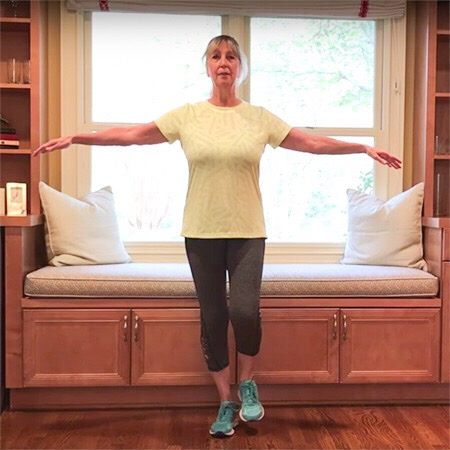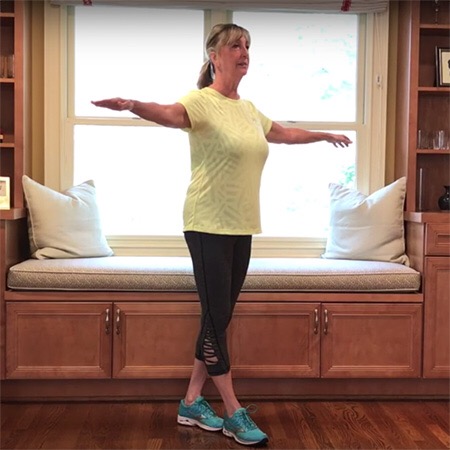3 Ways to Improve Your Balance
Stay strong and stable on your feet with these simple tips.

Balance training is usually an afterthought—as in, you never think about it until after you’ve taken a tumble. But that shouldn’t be the case.
By making a point to maintain or improve your balance now, you’ll help yourself prevent falls and injuries as you get older. Plus, you’ll feel more confident doing everyday activities like walking up and down stairs, cleaning the house, and playing with your grandkids, says Amy Haynes, D.P.T., lead physical therapist of the Fall Prevention and Balance Program at Tria Orthoapedic Center in Bloomington, Minnesota.
You don’t need to completely revamp your workout routine. In fact, if you’re already exercising regularly, there’s a good chance you’re working on your balance without even knowing it. That’s because many classic strength moves—like the ones in this full-body strength workout for beginners—don’t just work your muscles, but they also require coordination, balance, and stability.
No matter your current routine, it’s smart to give your balance some extra attention. Here are three easy ways to make sure you stay centered, stable, and safe.
1. Do This 4-Minute Routine Every Day
To stay stable on your feet, the National Institute on Aging suggests doing balance exercises as often as you can, including these two you can do at home or the gym.
Single-Leg Stands

Stand tall with your feet hip-width apart. If needed, hold on to a sturdy chair. Lift one foot, and keep it up for up to 10 seconds before placing it back on the floor. Repeat 10 to 15 times with each leg.
Heel-to-Toe Walk

Stand at one end of a room with clear space for walking. If needed, perform this move near a wall for support. Step one foot in front of you so that your front foot’s heel is touching or almost touching your back foot’s toes. Choose a spot in front of you to focus on, and imagine you’re walking on a tightrope. Aim for 20 steps in one direction before turning around to repeat in the other direction.
2. Switch Up Your Workouts
The more you move, the stronger your muscles and bones will be—and the better your balance will get. Any movement is always better than none, but to get the biggest balance bang for your buck, try to incorporate a variety of exercise styles in your weekly routine, Haynes says.
“Pilates, yoga, tai chi, and SilverSneakers classes can all be very beneficial,” she says. “Swimming and biking are also great low-impact, cardiovascular options for older adults.”
Research shows tai chi—a Chinese martial art that calls for using slow, focused movements while breathing deeply—may be especially effective at reducing the risk of falling. One study from the Oregon Research Institute found that doing tai chi three times per week can improve balance and reduce risk for falling by as much as 55 percent.
There’s no shortage of options when it comes to exercising for better balance. If yoga is more your speed, try these eight yoga poses that improve balance. Prefer traditional bodyweight movements? These six exercises for better stability can help you stay strong on your feet.
3. Work with a Physical Therapist
If you’ve fallen recently or suspect that you’re getting too wobbly, start by talking to your doctor, who can help you get any necessary treatment and check for any underlying issues. Let your doctor know about any chronic conditions and all prescriptions, over-the-counter drugs, or supplements you take.
Subscribe to our newsletter
It's quick and easy. You could be one of the 13 million people who are eligible.
Already a member? Click to discover our 15,000+ participating locations.
Follow Us
Your doctor may also recommend working with a physical therapist. A physical therapist understands the different areas of your body that control stability—including your inner ears, eyes, and core muscles—and can customize a plan designed to tackle your personal weaknesses.
“Each patient is unique,” Haynes says. “Typically, we’ll recommend a combination of stretching, posterior muscle strengthening, and standing balance exercises, as well as a walking plan.”
In this type of program, you can typically expect to work one-on-one with your physical therapist for 30 to 45 minutes at least once per week, Haynes says.
Take Your Favorite SilverSneakers Classes Online!
SilverSneakers members can access live fitness classes and wellness workshops through SilverSneakers LIVE. See the latest schedule and RSVP for classes here.
Not a member? If you have a Medicare Plan, it may include SilverSneakers—at no additional cost. Check your eligibility instantly here.





